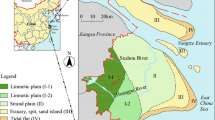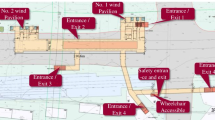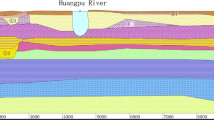Abstract
In China, more and more underground structures are being built close to buildings of architectural merit. When installing deep foundations, three ways of controlling seepage are suggested. In Mode III, an installed curtain extends partly into the confined aquifer so that the hydraulic connection between the excavated section and the water in the host material is partly isolated. The combined effects of pumping, curtain efficiency and recharge are discussed. Based on the engineering geological conditions of the deep foundation pit of the Yishan Road Station of Metro Line 9, Shanghai, China, in situ pumping and recharge tests were carried out. The combined effects are similar to the results obtained using a three-dimensional finite difference method (FDM) numerical simulation.
Résumé
En Chine, des structures souterraines de plus en plus nombreuses sont construites à proximité de bâtiments présentant un intérêt architectural. Trois moyens de contrôler les écoulements lors de la réalisation des fondations profondes sont suggérés. Dans le Mode III, un rideau d’injection est réalisé, pénétrant partiellement dans l’aquifère captif de sorte que la connexion hydraulique entre le volume excavé et l’eau de la formation hôte est partiellement coupée. Les effets combinés du pompage, du rideau d’injection et d’une recharge hydraulique sont discutés. Considérant les conditions géologiques et géotechniques de l’excavation profonde de la station Yishan Road de la ligne 9 à Shanghai (Chine), des essais de pompages in situ et des essais de recharge hydraulique ont été réalisés. Les effets obtenus sont semblables aux résultats issus d’une simulation numérique basée sur une méthode tridimensionnelle aux différences finies.





















Similar content being viewed by others
References
Mo YT (2002) Design and application of deep well and backfill well combined system. Housing Sci 9:12–14 (in Chinese)
Roy D, Robinson KE (2009) Surface settlements at a soft soil site due to bedrock dewatering. Eng Geol 107:109–117
Wang JX, Hu LS, Wu LG et al (2009) Hydraulic barrier function of the underground continuous concrete wall in the pit of subway station and its optimization. Environ Geol 57(2):447–453
WU LG (2003) Design and construction of dewatering engineering and theory of pit seepage. China Communication Press, Beijing (in Chinese)
Zhang YY, Gong XN (2007) Numerical simulation of recharging during dewatering of foundation pit. Water Resour Hydropower Eng 38(4):48–50 (in Chinese)
Zheng YC (2007) Application of recharging technique in dewatering of foundation pit. Site Investig Sci Technol 3:37–39 (in Chinese)
Acknowledgments
This work presented in this paper was supported by the research grant (No. 41072205, No. 50579097) from National Natural Science Foundation of China, the research grant (No. 10ZR1431500) from Shanghai Natural Science Foundation of China.
Author information
Authors and Affiliations
Corresponding author
Rights and permissions
About this article
Cite this article
Wang, J., Feng, B., Liu, Y. et al. Controlling subsidence caused by de-watering in a deep foundation pit. Bull Eng Geol Environ 71, 545–555 (2012). https://doi.org/10.1007/s10064-012-0420-0
Received:
Accepted:
Published:
Issue Date:
DOI: https://doi.org/10.1007/s10064-012-0420-0
Keywords
- Dewatering
- Subsidence control
- Pumping/curtain/recharge effect
- Deep foundation pit
- Pumping test
- Numerical simulation




